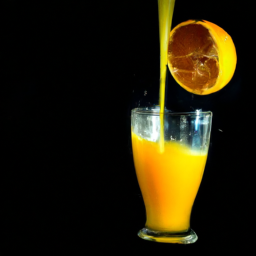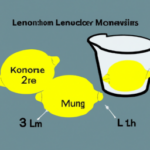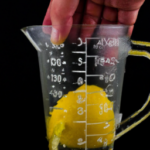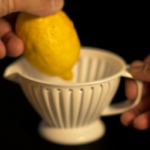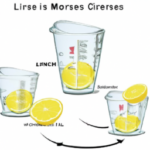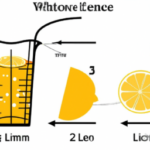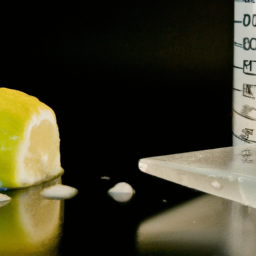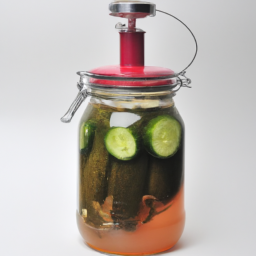You may be wondering, “Why is the quantity of juice from half a lemon important?”
Well, my friend, as a seasoned cook and baker, I can tell you that the amount of juice in a half lemon can make all the difference in a recipe. Lemon juice is a versatile ingredient that adds a tangy, bright flavor to dishes ranging from salads to desserts. And if you’re like me, you want to make sure you’re using the right amount of juice for each recipe to ensure optimal flavor.
But how do you know how much juice to expect from a half lemon? It’s not always a straightforward answer, as various factors can affect the amount of juice you can extract.
In this article, I’ll explore what those factors are, share tips for getting the most juice out of a half lemon, and even provide some recipe ideas that use half a lemon. So, let’s dive in and discover just how much juice is in a half a lemon.
Key Takeaways
- Factors such as ripeness, storage conditions, and extraction method can affect the amount of juice in a lemon.
- A ripe and juicy lemon contains about 1-2 tablespoons (15-30 mL) of juice, and using a measuring cup is the easiest way to determine how much juice is in a half lemon.
- Lemon juice contains high levels of vitamin C and antioxidants that can aid in digestion and promote hydration.
- Proper storage methods, such as storing half lemons in an airtight container or with a little bit of water, can keep them fresh for up to a week.
Overview of the Importance of Juice in Recipes
Juice is a crucial ingredient in many recipes and can make all the difference in taste, so it’s important to know how much is needed for each dish.
The importance of acidity in cooking cannot be overstated, and lemon juice is a great source of this essential element. The sour taste of lemon juice can balance out the sweetness of other ingredients, making it a popular choice in both savory and sweet dishes.
In addition to its role in cooking, lemon juice also has several health benefits. It contains high levels of vitamin C, which can boost the immune system, as well as antioxidants that can help protect against certain diseases.
Incorporating lemon juice into your diet can also aid in digestion and promote hydration. With all these benefits, it’s easy to see why knowing how much juice is in half a lemon is so important.
But what factors affect the amount of juice in a lemon? Let’s explore.
Factors that Affect the Amount of Juice in a Half Lemon
You won’t believe how different the amount of liquid can be when you squeeze a fresh lemon that’s been sitting out versus one that’s just been cut. Several factors can affect the juiciness of a lemon, such as the ripeness of the fruit, its storage conditions, and the method used to extract the juice. For example, a lemon that’s fully ripe and has been stored at room temperature is likely to yield more juice than one that’s underripe and has been stored in the fridge. Similarly, squeezing a lemon by hand may result in a different amount of juice than using a juicer or a reamer.
To illustrate the impact of these factors, consider the following table that shows the amount of juice I obtained from three different half lemons that were identical in size and shape, but varied in ripeness and storage conditions:
| Half Lemon | Ripe/Firmness | Storage | Juiciness |
|---|---|---|---|
| A | Fully Ripe | Room | High |
| B | Underripe | Fridge | Low |
| C | Semi-ripe | Counter | Medium |
As you can see, the juiciness of a half lemon can vary greatly depending on its ripeness and storage conditions. This is important to keep in mind when preparing recipes that require a specific amount of lemon juice, as using a half lemon that is less juicy than expected could result in a less flavorful or textured dish. With this in mind, let’s explore the average amount of juice that can be expected from a half lemon.
Average Amount of Juice in a Half Lemon
By examining the properties of a ripe and juicy lemon, one can determine the average amount of liquid present in a halved fruit. The amount of juice in a half lemon can vary depending on factors like the size of the fruit, its ripeness, and the time of year. However, on average, a half lemon contains about 1-2 tablespoons (15-30 mL) of juice.
To extract the most juice from a half lemon, a lemon squeezer can be used. This tool works by pressing the lemon halves against a ridged surface, which separates the juice from the pulp. Additionally, the acidic content of the lemon can also be a factor in the amount of juice extracted. The higher the acidity, the more juice that can be extracted.
With these factors in mind, one can get the most juice out of a half lemon to use in cooking, baking, or as a refreshing drink.
Tips for Getting the Most Juice Out of a Half Lemon
To maximize the amount of citrusy goodness in your recipes, try using a lemon squeezer or manually squeezing the fruit with your hands. Creative uses of lemons can include adding juice to marinades, dressings, or cocktails, or even using the zest to add flavor to baked goods.
When it comes to juice extraction techniques, there are a few things to keep in mind. First, make sure the lemon is at room temperature before squeezing. This will help the juice flow more easily.
Next, roll the lemon on a hard surface, applying pressure with the palm of your hand. This helps to break down the individual juice sacs inside the fruit and release more juice. When squeezing, use a firm but gentle grip to avoid breaking the seeds and releasing bitter compounds into the juice.
Finally, if you’re manually squeezing the lemon, start with the cut side facing down to get the most juice out.
With these tips, you’ll be able to get the most out of your half lemon and add bright, zesty flavor to your dishes.
To measure lemon juice for recipes, it’s important to know how much juice is typically in a half lemon. From there, you can adjust the amount based on your recipe’s needs. So, let’s move on to the next section and find out just how much juice you can expect from half a lemon.
How to Measure Lemon Juice for Recipes
When it comes to measuring lemon juice for recipes, I prefer to use a measuring cup. This ensures that the exact amount of juice needed for the recipe is added.
If a recipe calls for the juice of a certain number of lemons, I count them and then measure out the juice accordingly.
However, if the recipe only calls for a small amount of lemon juice, I may just eyeball it and adjust as needed.
Use a Measuring Cup
Using a measuring cup is the easiest way to determine how much juice is in a half lemon, as it allows for precise measurements and less mess. When preparing a recipe that calls for lemon juice, I always use a measuring cup to ensure that I have the correct amount.
Here are some tips for using a measuring cup to extract lemon juice:
- Cut the lemon in half and gently squeeze it over the measuring cup, using a spoon to press out any remaining juice.
- Hold the measuring cup over a bowl or sink to catch any spills or drips.
- Use a fine mesh strainer to remove any pulp or seeds that may have fallen into the measuring cup.
- Be sure to measure the juice at eye level, to ensure accuracy.
- If the recipe calls for a specific amount of juice, measure out the required amount and set aside.
Counting the number of lemons you need for a recipe is another way to determine how much juice is in a half lemon. By knowing how much juice is typically extracted from a lemon, you can estimate how many lemons you need to achieve the desired amount of juice. However, using a measuring cup is the most accurate way to ensure that you have the right amount of lemon juice for your recipe.
Count the Number of Lemons
Counting how many lemons you need can be a fun and easy way to ensure you have just the right amount of zesty flavor in your recipe. The amount of juice in half a lemon can vary based on the type of lemon you’re using. For example, Meyer lemons are juicier and sweeter than Eureka lemons. Therefore, you may need more Eureka lemons to get the same amount of juice as one Meyer lemon.
To determine the number of lemons needed, it’s important to consider the size and juiciness of the lemons you have on hand. A general rule of thumb is that one average-sized lemon will yield approximately two tablespoons of juice. However, if you’re using particularly juicy lemons, you may only need one or two to get the desired amount of juice. On the other hand, if you’re using less juicy lemons, you may need three or four to achieve the same result.
Estimating the number of lemons needed is just one method of measuring the amount of juice you need. However, if you prefer a more precise measurement, you can also use a measuring cup.
Eyeball it
You can simply eyeball the amount of lemon juice you need for your recipe, but be aware that this method may not always yield consistent results. Estimating yield can be tricky, especially if the size of the lemon and its juiciness vary from one fruit to another.
However, in most cases, half a lemon will provide around 1-2 tablespoons of juice, which is equivalent to about 15-30 mL. Measuring accuracy is crucial when it comes to baking or cooking, as even slight variations in the amount of ingredients can affect the final outcome of your dish. For this reason, many recipes will specify the exact amount of lemon juice needed, rather than simply stating “the juice of half a lemon.” If you’re ever unsure of **how much juice from half a lemon** your recipe requires, it’s always a good idea to measure it out for consistency. This helps ensure that your dish turns out well-balanced in flavor every time.
If you need a precise amount of lemon juice, it’s best to use a juicer or a measuring cup. Alternatively, you can also try using bottled lemon juice, which is pre-measured and has a consistent flavor. With these tips, you can ensure that your recipe turns out just right.
Now, let’s explore some substitutions for lemon juice.
Substitutions for Lemon Juice
If you’re looking for a tangy alternative to lemon juice, try using lime or grapefruit juice instead. These citrus fruits offer similar tartness and acidity to lemon juice, making them great substitutes in recipes.
Here are some benefits of using lemon juice substitutes:
- Variety: Using different citrus juices can add a unique twist to familiar recipes.
- Accessibility: If lemons aren’t readily available, limes or grapefruits may be easier to find.
- Health benefits: Citrus fruits are a great source of Vitamin C, which can boost immunity and promote healthy skin.
- Cost-effective: Depending on the season and location, lime or grapefruit juice may be more affordable than lemon juice.
- Flavor profile: Lime juice can add a slightly sweeter and more floral flavor, while grapefruit juice can add a bitter and tangy flavor to dishes.
Now, if you’re wondering what recipes use half a lemon, there are plenty of options! From salad dressings to marinades, half a lemon can add a bright and zesty flavor to many dishes.
Recipes that Use Half a Lemon
As we discussed in the previous subtopic, there are many substitutions for lemon juice that can be used in recipes. However, sometimes a recipe specifically calls for half a lemon and it’s important to know how much juice that yields. The amount of juice in a half a lemon can vary depending on the size and ripeness of the lemon, but on average it yields about 1 tablespoon of juice.
Knowing how much juice is in a half a lemon is useful when making recipes that call for this specific measurement. Some examples of recipes that use half a lemon include salad dressings, marinades, and cocktails. It’s important to note that lemon halves can also be stored in the fridge for later use. Simply wrap the remaining half in plastic wrap and place it in the fridge. It will stay fresh for a few days and can be used in other recipes or even as a garnish for drinks.
Moving on to the next topic, there are many other uses for lemon halves besides just squeezing out the juice.
Other Uses for Lemon Halves
Get ready to discover some creative uses for those leftover lemon halves! Did you know that lemon halves can be used to preserve freshness in your fridge? Simply place a cut lemon half in a plastic container with your fruits and vegetables to help keep them fresh for longer. The acidity of the lemon helps to slow down the oxidation process which causes produce to spoil.
Lemon halves can also be used as a natural cleaning solution. Rubbing a lemon half on copper pots and pans can help remove tarnish and bring back their shine. They can also be used to clean cutting boards and remove stains from fabrics. With so many creative uses for leftover lemon halves, there’s no need to waste any part of this versatile fruit.
When it comes to storing half lemons, there are a few simple steps you can take to keep them fresh. One option is to wrap them tightly in plastic wrap and store them in the fridge. Another option is to place them cut-side down on a plate and cover them with a small bowl or lid. This will help prevent them from drying out and losing their flavor.
By following these storage tips and getting creative with their uses, you can make the most out of your leftover lemon halves.
Storing Half Lemons
To keep your lemons fresh and flavorful, all you need to do is store them properly using plastic wrap or a small bowl. Preserving the freshness of lemons is crucial in maximizing their use and flavor.
When storing half lemons, it is essential to keep them in an airtight container or wrap them with plastic to prevent moisture from escaping and the fruit from drying out. For best storage methods, place the cut side of the lemon down on a small plate or in a small bowl, then wrap it tightly with plastic wrap. Alternatively, you can also store your lemon halves in an airtight container with a little bit of water to keep them from drying out.
This method ensures that the lemons remain fresh for up to a week, allowing you to use them for various purposes such as adding flavor to your water, marinades, or salad dressings. Using leftover lemon halves has never been easier with these simple storage methods that keep your lemons fresh, juicy, and flavorful.
Frequently Asked Questions
Can you use a lime instead of a lemon for recipes that call for half a lemon?
Yes, a lime can be used instead of a lemon for recipes that call for half a lemon. However, it is important to note that there may be flavor differences between the two fruits due to their varying levels of acidity and sweetness.
How long can you store a half lemon before it goes bad?
To prevent spoilage, store cut lemons in an airtight container in the refrigerator for up to a week. Proper storage slows down the oxidation process that leads to spoilage.
Is it better to squeeze a lemon by hand or use a juicer?
When it comes to lemon juice, the method of extraction can impact quality. Hand squeezing allows for control over pulp and acidity, while a juicer may introduce unwanted bitterness. Choosing the right method depends on personal preference and recipe requirements.
Can you freeze leftover lemon juice for future use?
I’ve found that freezing leftover lemon juice is a convenient way to always have it on hand for lemonade recipes. Just be sure to use an airtight container and label it with the date, as frozen juice can last up to six months.
Are there any potential health benefits to consuming lemon juice?
Benefits explored, Lemon myths debunked. Consuming lemon juice may aid digestion, boost immunity, and provide a source of vitamin C. However, excessive intake may harm tooth enamel. Always consult a healthcare professional before starting any new diet or supplement regimen.
Conclusion
In conclusion, the amount of juice in a half lemon can vary depending on various factors such as the ripeness of the fruit, the method of juicing, and the size of the lemon. However, on average, a half lemon can yield around 1-2 tablespoons of juice.
To get the most juice out of a half lemon, try rolling the fruit on a hard surface, microwaving it for a few seconds, or using a citrus juicer.
While lemon juice is a staple ingredient in many recipes, it can also be substituted with other acidic ingredients such as vinegar or lime juice. Some recipes that use half a lemon include salad dressings, marinades, and cocktails.
And if you find yourself with leftover half lemons, they can be stored in the refrigerator for a few days or even frozen for later use.
Understanding the amount of juice in a half lemon can be a helpful tool in the kitchen and can lead to more precise and flavorful dishes.
Cindy thoroughly researches juicing trends, techniques, and recipes to provide readers with practical advice and inspiration. Her writing style is accessible, engaging, and designed to make complex concepts easy to understand. Cindy’s dedication to promoting the advantages of juicing shines through her work, empowering readers to make positive changes in their lives through the simple act of juicing.


